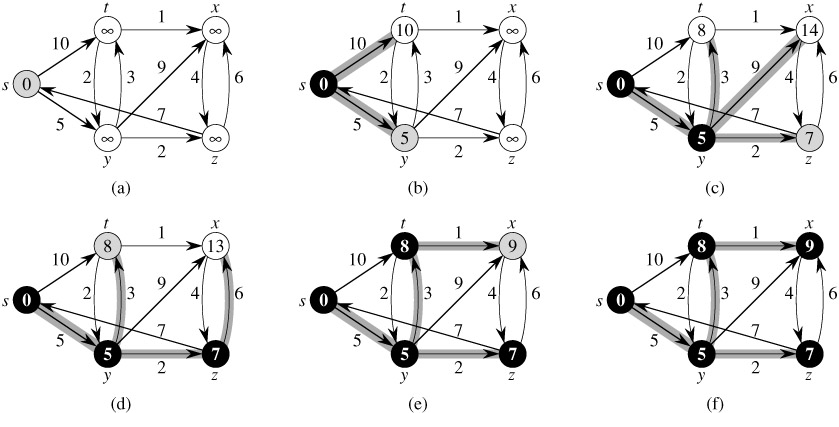介绍 Dijkstra算法(Dijkstra’s algorithm)是解决单源最短路径问题的一般算法。它的主要特点是以起始点为中心向外层层扩展(广度优先搜索思想),直到扩展到终点为止。
算法思想 在每个阶段,Dijkstra算法选择一个顶点v,它在所有未知顶点中具有最小的dv,同时声明从s到v的最短路径是已知的。阶段的其余部分由dw值的更新工作组成。
这里先明确两个集合:所有顶点集V和已选中顶点集S。
找到当前未选中点(V - S)中距离源点最近的点
更新未选中点到源点的距离
核心代码
我觉得<<数据结构与算法分析–C语言描述>>中的伪代码言简意赅,我将在Github中放上具体实现,此处就放上书上源码。
Dijkstra算法的声明 1 2 3 4 5 6 7 8 9 10 11 12 13 typedef int Vertex;struct TableEntery { List Header; int Known; DisType Dist; Vertex Path; }; # define NotAVertex (-1) typedef struct TableEntery Table [NumVertex ];
表初始化 1 2 3 4 5 6 7 8 9 10 11 12 13 void InitTable (Vertex Start, Graph G, Table T) int i; ReadGrap(G, T); for (i = 0 ; i < NumVertex; i++) { T[i].Known = False; T[i].Dist = Infinity; T[i].Path = NotAVertex; } T[Start].Dist = 0 ; }
显示实际最短路径 1 2 3 4 5 6 7 8 9 10 11 12 void PrintPath (Vertex V, Table T) if (T[V].Path != NotAVertex) { PrintPath(T[V].Path, T); printf (" to " ); } printf ("%v" , V); }
Dijkstra算法的伪代码 1 2 3 4 5 6 7 8 9 10 11 12 13 14 15 16 17 18 19 void Dijkstra (Table T) Vertex V, W; for (;;) { V = smallest unknown distance vertex; if (V == NotAVertex) break ; T[V].Known = True; for each W adjacent to V if (!T[W].Known) if (T[V].Dist + Cvw < T[W].Dist) { Decrease(T[W].Dist to T[V].Dist + Cvw); T[W].Path = V; } } }
总结 Dijkstra算法适用于图的边没有负值。时间复杂度也要看具体实现。
我个人认为,算法思路很容易理解,在代码的实现细节上可能存在一些难点。
